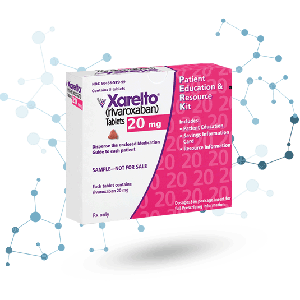Xarelto Overview - All About Factor Xa Inhibitors
 Xarelto® blood thinner medication is among the most popular anticoagulants on the market today. This prescription blood thinner earned over $4 billion for manufacturers Bayer and Johnson & Johnson in 2018. Anticoagulants help prevent blood clots and more serious medical complications such as strokes, heart attacks, or pulmonary embolisms. The U.S. Department of Health and Human Services reports that 4.2 million Americans aged 18 and older take blood thinners. Xarelto is among the most popular prescription brands available, comprising 17.5% of current market sales. If you’re a new blood thinner patient, read our Xarelto overview to decide whether it’s right for you.
Xarelto® blood thinner medication is among the most popular anticoagulants on the market today. This prescription blood thinner earned over $4 billion for manufacturers Bayer and Johnson & Johnson in 2018. Anticoagulants help prevent blood clots and more serious medical complications such as strokes, heart attacks, or pulmonary embolisms. The U.S. Department of Health and Human Services reports that 4.2 million Americans aged 18 and older take blood thinners. Xarelto is among the most popular prescription brands available, comprising 17.5% of current market sales. If you’re a new blood thinner patient, read our Xarelto overview to decide whether it’s right for you.
Xarelto Overview: How Does Xarelto Work?
Xarelto’s also known as rivaroxaban, which is the drug’s generic name. It works by blocking certain clotting proteins (called Factor Xa) within your blood. Xarelto belongs to a new wave of blood thinners that’s taking over a category dominated for decades by warfarin (Coumadin®). Thanks to warfarin’s comparatively low cost, it’s still widely used by 54% of blood thinner patients. Xarelto doesn’t require monthly blood monitoring visits with your doctor, but Coumadin does.
Xarelto is manufactured by drug giant Johnson & Johnson and distributed by Bayer. Rivaroxaban initially hit Canadian markets in 2008, but was approved by the U.S. Food and Drug Administration in July 2011.
On November 2, 2012, the FDA approved Xarelto to treat DVT (deep vein thrombosis) as well as PE (pulmonary embolism). “Today’s approvals distinguish Xarelto as having the broadest profile of any of the new oral anticoagulants in the U.S. market today or coming to market in the foreseeable future,” said the company’s press release.
Xarelto Overview: Who is Prescribed Xarelto Blood Thinner Medication?
Xarelto helps reduce stroke and blood clot risks for atrial fibrillation patients. It also prevents deep vein thrombosis (DVT) as well as pulmonary embolism (DE). Xarelto can also reduce recurrence risks for both conditions. Physicians often prescribe Xarelto after knee or hip replacement surgery to prevent blood clots in the patient’s legs and lungs.
Xarelto Overview: Uncontrolled Bleeding Episode Risks
While many physicians prescribe Xarelto to treat DVT and PE, consumers should explore all treatment options. In May 2018, the FDA finally approved a Xarelto antidote called AndexXa that also works on Eliquis patients. (Warfarin patients use Vitamin K to reverse its anticoagulant effects.) Prior to that, doctors had no way to stop emergency bleeding episodes. And even now that doctors have an approved Xarelto reversal agent, internal bleeding can turn deadly if it’s not detected almost immediately.
Dr. Charles Pollack, emergency physician at Thomas Jefferson University Hospital in Philadelphia, says: “[Major bleeding events] may be uncommon, but they’re memorable when they happen. We didn’t have a specific reversal strategy for these drugs, and I think that left people feeling a bit insecure.”
Other possible Xarelto side effects include:
- Fainting
- Itching
- Pain in arms as well as legs
- Muscle pain
- Muscle spasms
If you experience a major bleeding episode while taking Xarelto, you may qualify for compensation. Since Bayer as well as Johnson & Johnson failed to warn consumers about Xarelto’s internal bleeding risks, plaintiffs filed at least 25,000 lawsuits. Luckily, the FDA approved the first Xarelto reversal agent, AndexXa, in 2018.
Xarelto Overview: Bayer, J&J Settle 25,000 Claims for $775 Million in March 2019
On March 25, 2019, both companies agreed to settle all 25,000 outstanding Xarelto lawsuits for a staggering $775 million. Both companies agreed to split payments without admitting any liability for plaintiffs’ uncontrolled bleeding injuries as well as any deaths.
Check eligibility for compensation.
If you or a loved one developed life-threatening Xarelto complications (such as uncontrolled bleeding), you may qualify for compensation from the manufacturer. Request your free case evaluation now to see if you may qualify.
Lori Polemenakos is Director of Consumer Content and SEO strategist for LeadingResponse, a legal marketing company. An award-winning journalist, writer and editor based in Dallas, Texas, she's produced articles for major brands such as Match.com, Yahoo!, MSN, AOL, Xfinity, Mail.com, and edited several published books. Since 2016, she's published hundreds of articles about Social Security disability, workers' compensation, veterans' benefits, personal injury, mass tort, auto accident claims, bankruptcy, employment law and other related legal issues.




